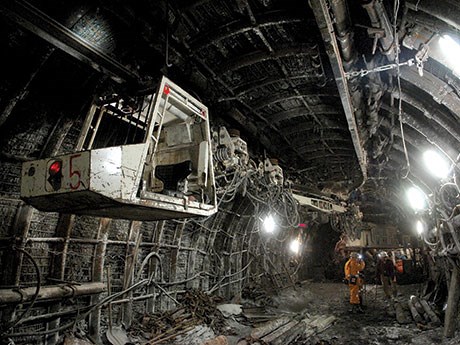SMT Scharf sees application for monorail technology in hard rock mines
The recent $8 million acquisition of mobile equipment manufacturer RDH Mining of Alban, Ontario, 45 kilometres south of Sudbury, by SMT Scharf of Germany, creates a company with a broad range of rail and rubber tire transportation solutions.
Based in Hamm, Germany, 40 kilometres northeast of Dortmund, SMT Scharf was founded in 1941 to serve the underground transportation needs of the country’s coal mining industry.
At the time, Germany had hundreds of coal mines, said CEO Joachim Theiss in an interview with Sudbury Mining Solutions Journal. “We developed a monorail solution suspended from the ceiling to make it independent of floor conditions.”
The mines were quite deep and were contending with “floor heave, which made it very difficult to maintain a smooth and even floor,” so SMT Scharf’s self-propelled monorails were a perfect solution for transporting supplies, equipment and personnel.
Knowing well in advance that the German coal industry was going to be shut down in 2018 in accordance with the country’s transition to clean energy, the company embarked on a market diversification strategy.
In 1999, said Theiss, Germany accounted for between 75 and 80 per cent of SMT Scharf’s sales. “Today, it’s just three per cent.”
SMT Scharf sales staff in Poland, Russia, China, South Africa and Chile will help boost sales for RDH’s rubber tire products, while RDH staff in Alban will help its German parent open doors for its rail-based solutions in North America.
“We will be able to offer a one-stop shop for underground logistics,” said Theiss.
The company has 390 employees and reported sales of €42.5 million or C$66 million prior to the acquisition.
Monorail systems account for more than 50 per cent of SMT Scharf’s rail business. The company also designs and manufactures floor-mounted systems, cable handling systems and ceiling-suspended chair lifts. The latter, sold primarily to hard rock mines in South Africa and similar to chair lifts used on ski hills, are used to transport miners underground.
Theiss is optimistic about the potential for the company’s monorail and cable handling systems in North America’s hard rock mines.
“We had good meetings at the PDAC in Toronto with mining companies and we’re sure that within 12 to 30 months, we will see monorail transportation systems in North America.”
Using electric-powered monorails in smaller hard rock mines allows for declines or ramps to be built using steeper gradients and smaller openings than would be possible using trucks for haulage.
“Steeper is cheaper,” claims Theiss, because it takes less time and money to get to the orebody.
The energy generated during descent is fed back into the grid, there are no batteries and no need to interrupt production for charging. They can pick up and drop loads everywhere in the mine by means of integrated lifting devices, and can also be used to haul ore.
Cable handling systems, another SMT Scharf product, have traditionally been sold to coal operations using longwall mining technology, but are also required for other continuous mining systems.
Currently, SMT Scharf is testing what is likely the largest cable handling system in the world for a potash mine in Canada. Most cable handling systems expand from 80 or 100 metres to 300 or 350 metres. The prototype now installed in a mine in Germany for testing expands from 350 or 380 metres to 2.8 kilometres and is able to turn around corners, said Theiss.
The coal industry remains an important market for the company despite decisions by Germany and other countries, including Canada, to phase out coal-fired power plants.
“The coal industry is not really shrinking,” said Theiss. “In 2016, coal shrank 0.3 per cent, but on average the coal industry has been growing at a compounded rate averaging two per cent per year for the last 20 or 25 years.”
In Poland and Australia, it’s stable, but in Russia and China, coal mining is growing to meet the energy needs of the world.
“My prediction is that we will see a stable or slightly growing coal market for a minimum of 10 to 20 years,” said Theiss.
RDH, described by Theiss as “the Tesla of the underground mining industry,” was an attractive target because of its expertise in battery-powered equipment and its focus on hard rock mining.
“Our analysis was that RDH is well ahead of other equipment manufacturers, including the big players in the market,” said Theiss.
The four RDH partners remain with the company, but in slightly different roles. Neil Edward and Gustavo Portalier will serve as managing directors in addition to their roles as chief financial officer and chief operating officer, respectively, while Kevin Fitzsimmons and Jeannot Courchesne have both been named vice-presidents responsible for international sales.
According to Edward, the acquisition by SMT Scharf allows RDH to move to the next level of growth, expand export sales and develop a full range of battery-powered equipment for the underground market.


